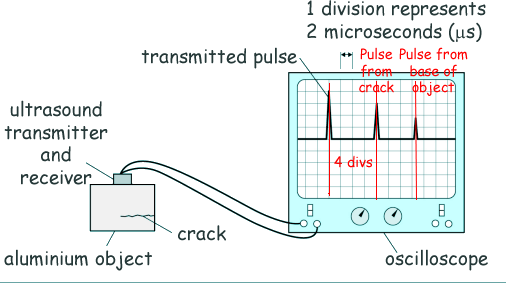GCSE Questions - Waves Q15. (a) The table below gives the frequencies in the hearing ranges of five different animals.
Which one of these animals would not be able to hear ultrasound? The chicken [1 mark] (b) The diagram shows ultrasound being used to detect a hidden crack in a solid aluminium object. The transmitted and reflected pulses of ultrasound are shown on the screen.
Tick the one of the following that is the same as 2 microseconds.
[1 mark] Ultrasound travels at 6300 m/s in aluminium. Determine the depth of the crack below the top surface of the aluminium. Use information from the diagram and give your answer to two significant figures. 4 divisions = 8 μs This is time to travel from the surface to the crack and back again. Time to travel to the crack is 4 μs distance = speed x time distance = 6300 x 4 x 10-6 distance = 2.52 x 10-2m distance = 2.5 x 10-2m distance = 0.025 m [4 marks] (c) Here is a diagram that shows the parts of a moving-coil microphone.
[1 mark]
[4 marks] (Total 11 marks) |
Follow me...
|







